Biochar Integration with Legume Crops in Summer Gape Synergizes Nitrogen Use Efficiency and Enhance Maize Yield
Abstract
1. Introduction
2. Materials and Methods
2.1. Location and Cropping History of Experimental Area
2.2. General Experimental Details
2.3. Experimental Design and Agronomic Practices
2.4. Characteristics and Method of Biochar Preparation
2.5. Determination of N and C Content in Soil and Plant Samples
2.6. Dry Matter and Grain Yield of Maize
2.7. Statistical Analysis
3. Results
3.1. Soil Properties
3.1.1. Soil C after Maize Harvest (g kg−1)
3.1.2. Soil N after Maize Harvest (g kg−1)
3.2. Maize N Content
3.2.1. Stover N in Maize (g kg−1)
3.2.2. Grain N in Maize (g kg−1)
3.3. Nitrogen (N) Use Efficiency
3.4. Above Ground Biomass and Grain Yield of Maize
3.4.1. Above Ground Biomass (kg ha−1)
3.4.2. Grain Yield (kg ha−1)
4. Discussion
4.1. Soil Properties
4.2. Maize N Content and NUE
4.3. Above Ground Biomass and Grain Yield of Maize
5. Conclusions
Author Contributions
Funding
Conflicts of Interest
References
- Reis, S.; Bekunda, M.; Howard, C.M.; Karanja, N.; Winiwarter, W.; Yan, X.Y.; Bleeker, A.; Sutton, M.A. Synthesis and review: Tackling the nitrogen management challenge: From global to local scales. Environ. Res. Lett. 2016, 11, 120205. [Google Scholar] [CrossRef]
- Norse, D.; Ju, X.T. Environmental costs of China’s food security. Agric. Ecosyst. Environ. 2015, 209, 5–14. [Google Scholar] [CrossRef]
- Woolf, D.; Amonette, J.E.; Street-Perrott, F.A.; Lehmann, J.; Joseph, S. Sustainable biochar to mitigate global climate change. Nat. Commun. 2010, 1, 56. [Google Scholar] [CrossRef] [PubMed]
- Arif, M.; Ilyas, M.; Riaz, M.; Ali, K.; Shah, K.; Haq, U.I.; Fahad, S. Biochar improves phosphorus use efficiency of organic-inorganic fertilizers, maize–wheat productivity and soil quality in a low fertility alkaline soil. Field Crops Res. 2017, 214, 25–37. [Google Scholar] [CrossRef]
- Lehmann, J.; Gaunt, J.; Rondon, M. Bio-char sequestration in terrestrial ecosystems—A review. Mitig. Adapt. Strateg. Glob. Chang. 2006, 11, 403–427. [Google Scholar] [CrossRef]
- Glaser, B.; Lehmann, J.; Zech, W. Ameliorating physical and chemical properties of highly weathered soils in the tropics with charcoal—A review. Biol. Fertil. Soils 2002, 35, 219–230. [Google Scholar] [CrossRef]
- Yamato, M.; Okimori, Y.; Wibowo, I.; Anshori, S.; Ogawa, M. Effects of the application of charred bark of Acacia mangium on the yield of maize [Zea mays], cowpea [Vigna unguiculata] and peanut [Arachis hypogaea], and soil chemical properties in South Sumatra, Indonesia. Soil Sci. Plant Nutr. 2006, 52, 489–495. [Google Scholar] [CrossRef]
- Steiner, C.; Teixeira, W.G.; Lehmann, J.; Nehls, T.; de Macêdo, J.L.V.; Blum, W.E.; Zech, W. Long term effects of manure, charcoal and mineral fertilization on crop production and fertility on a highly weathered Central Amazonian upland soil. Plant Soil 2007, 291, 275–290. [Google Scholar] [CrossRef]
- Li, Z.; Delvaux, B. Phytolith-rich biochar: A potential Si fertilizer in desilicated soils. Glob. Chang. Biol. Bioenergy 2019, 11, 1264–1282. [Google Scholar] [CrossRef]
- Li, Z.; Delvaux, B.; Yans, J.; Dufour, N.; Houben, D.; Cornelis, J.-T. Phytolith-rich biochar increases cotton biomass and silicon-mineralomass in a highly weathered soil. J. Plant Nutr. Soil Sci. 2018, 181, 537–546. [Google Scholar] [CrossRef]
- Nelissen, V.; Rütting, T.; Huygens, D.; Staelens, J.; Ruysschaert, G.; Boeckx, P. Maize biochars accelerate short-term soil nitrogen dynamics in a loamy sand soil. Soil Biol. Biochem. 2012, 55, 20–27. [Google Scholar] [CrossRef]
- Anderson, C.R.; Condron, L.M.; Clough, T.J.; Fiers, M.; Stewart, A.; Hill, R.A.; Sherlock, R.R. Biochar induced soil microbial community change: Implications for biogeochemical cycling of carbon, nitrogen and phosphorus. Pedobiologia 2011, 54, 309–320. [Google Scholar] [CrossRef]
- Zimmerman, A.R.; Gao, B.; Ahn, M.-Y. Positive and negative carbon mineralization priming effects among a variety of biochar-amended soils. Soil Biol. Biochem. 2011, 43, 1169–1179. [Google Scholar] [CrossRef]
- Schomberg, H.H.; Gaskin, J.W.; Harris, K.; Das, K.; Novak, J.M.; Busscher, W.J.; Watts, D.W.; Woodroof, R.H.; Lima, I.M.; Ahmedna, M. Influence of biochar on nitrogen fractions in a coastal plain soil. J. Environ. Qual. 2012, 41, 1087–1095. [Google Scholar] [CrossRef]
- Luo, Y.; Durenkamp, M.; De Nobili, M.; Lin, Q.; Brookes, P. Short term soil priming effects and the mineralisation of biochar following its incorporation to soils of different pH. Soil Biol. Biochem. 2011, 43, 2304–2314. [Google Scholar] [CrossRef]
- Habtegebrial, K.; Singh, B.; Haile, M. Impact of tillage and nitrogen fertilization on yield, nitrogen use efficiency of tef (Eragrostis tef (Zucc.) Trotter) and soil properties. Soil Tillage Res. 2007, 94, 55–63. [Google Scholar] [CrossRef]
- Ogola, J.; Wheeler, T.; Harris, P. Effects of nitrogen and irrigation on water use of maize crops. Field Crops Res. 2002, 78, 105–117. [Google Scholar] [CrossRef]
- Yang, J.; Huffman, E.; De Jong, R.; Kirkwood, V.; MacDonald, K.; Drury, C. Residual soil nitrogen in soil landscapes of Canada as affected by land use practices and agricultural policy scenarios. Land Use Policy 2007, 24, 89–99. [Google Scholar] [CrossRef]
- Khan, A.; Jan, M.T.; Marwat, K.B.; Arif, M. Organic and inorganic nitrogen treatments effects on plant and yield attributes of maize in a different tillage system. Pak. J. Bot. 2009, 41, 99–108. [Google Scholar]
- Malhi, S.S.; Lemke, R.; Wang, Z.; Chhabra, B.S. Tillage, nitrogen and crop residue effects on crop yield, nutrient uptake, soil quality, and greenhouse gas emissions. Soil Tillage Res. 2006, 90, 171–183. [Google Scholar] [CrossRef]
- Pierce, F.J.; Rice, C.W. Crop Rotation and Its Impact on Efficiency of Water and Nitrogen Use 1. In Cropping Strategies for Efficient Use of Water and Nitrogen; ASA Special Publication—American Society of Agronomy (USA): Madison, WI, USA, 1988; pp. 21–42. [Google Scholar]
- Akhtar, K.; Wang, W.; Khan, A.; Ren, G.; Afridi, M.Z.; Feng, Y.; Yang, G. Wheat straw mulching offset soil moisture deficient for improving physiological and growth performance of summer sown soybean. Agric. Water Manag. 2019, 211, 16–25. [Google Scholar] [CrossRef]
- Bremner, J.M.; Mulvaney, C. Nitrogen total 1. Methods of soil analysis. Part 2. Chem. Microbiol. Prop. 1982, 2, 595–624. [Google Scholar]
- Walkley, A.; Black, I.A. An examination of the Degtjareff method for determining soil organic matter, and a proposed modification of the chromic acid titration method. Soil Sci. 1934, 37, 29–38. [Google Scholar] [CrossRef]
- Sharma, A.; Behera, U. Nitrogen contribution through Sesbania green manure and dual-purpose legumes in maize—Wheat cropping system: Agronomic and economic considerations. Plant Soil J. 2009, 325, 289–304. [Google Scholar] [CrossRef]
- Jan, M.; Shah, P.; Hollington, P.; Khan, M.; Sohail, Q. Agriculture Research: Design and Analysis, a Monograph; NWFP Agricultural Univniversity Peshawar: Peshawar, Pakistan, 2009. [Google Scholar]
- Akhtar, K.; Wang, W.; Ren, G.; Khan, A.; Feng, Y.; Yang, G. Changes in soil enzymes, soil properties, and maize crop productivity under wheat straw mulching in Guanzhong, China. Soil Tillage Res. 2018, 182, 94–102. [Google Scholar] [CrossRef]
- Savithri, P.; Subbiah, S.; Malarvili, P.; Gopalsamy, A. Effect of coir pith based poultry litter on yield and nutrient uptake by sorghum cowpea cropping system. In Proceedings of the Seminar on Utilization of Coir Pith in Agriculture, Coimbatore, India, 20 November 1991; TNAU: Coimbatore, India. [Google Scholar]
- Parmar, D.K.; Sharma, V. Nitrogen requirement of single hybrid maize (Zea mays) wheat (Triticumaestivum) system under rainfed conditions. Indian J. Agric. Sci. 2001, 71, 252–254. [Google Scholar]
- Akhtar, K.; Wang, W.; Khan, A.; Ren, G.; Zaheer, S.; Sial, T.A.; Feng, Y.; Yang, G. Straw mulching with fertilizer nitrogen: An approach for improving crop yield, soil nutrients and enzyme activities. Soil Use Manag. 2019, 35, 526–535. [Google Scholar] [CrossRef]
- Iqbal, A.; He, L.; Khan, A.; Wei, S.; Akhtar, K.; Ali, I.; Ullah, S.; Munsif, F.; Zhao, Q.; Jiang, L. Organic Manure Coupled with Inorganic Fertilizer: An Approach for the Sustainable Production of Rice by Improving Soil Properties and Nitrogen Use Efficiency. Agronomy 2019, 9, 651. [Google Scholar] [CrossRef]
- Steiner, C.; Glaser, B.; Geraldes Teixeira, W.; Lehmann, J.; Blum, W.E.; Zech, W. Nitrogen retention and plant uptake on a highly weathered central Amazonian Ferralsol amended with compost and charcoal. J. Plant Nutr. Soil Sci. 2008, 171, 893–899. [Google Scholar] [CrossRef]
- Ahmad, F.; Ahmad, I.; Khan, M. Screening of free-living rhizospheric bacteria for their multiple plant growth promoting activities. Microbiol. Res. 2008, 163, 173–181. [Google Scholar] [CrossRef]
- Wang, W.; Akhtar, K.; Ren, G.; Yang, G.; Feng, Y.; Yuan, L. Impact of straw management on seasonal soil carbon dioxide emissions, soil water content, and temperature in a semi-arid region of China. Sci. Total Environ. 2019, 652, 471–482. [Google Scholar] [CrossRef] [PubMed]
- Akhtar, K.; Wang, W.; Ren, G.; Khan, A.; Feng, Y.; Yang, G.; Wang, H. Integrated use of straw mulch with nitrogen fertilizer improves soil functionality and soybean production. Environ. Int. 2019, 132, 105092. [Google Scholar] [CrossRef] [PubMed]
- Haefele, S.; Konboon, Y.; Wongboon, W.; Amarante, S.; Maarifat, A.; Pfeiffer, E.; Knoblauch, C. Effects and fate of biochar from rice residues in rice-based systems. Field Crops Res. 2011, 121, 430–440. [Google Scholar] [CrossRef]
- Khan, A.; Kong, X.; Najeeb, U.; Zheng, J.; Tan, D.K.Y.; Akhtar, K.; Munsif, F.; Zhou, R. Planting Density Induced Changes in Cotton Biomass Yield, Fiber Quality, and Phosphorus Distribution under Beta Growth Model. Agronomy 2019, 9, 500. [Google Scholar] [CrossRef]
- Manzar-ul-Alam, S.; Shah, S.A.; Ali, S.; Iqbal, M.M. Yield and phosphorus-uptake by crops as influenced by chemical fertilizer and integrated use of industrial by-products. Songklanakarin J. Sci. Technol. 2005, 27, 9–16. [Google Scholar]
- Jien, S.H.; Wang, C.S. Effects of biochar on soil properties and erosion potential in a highly weathered soil. Catena 2013, 110, 225–233. [Google Scholar] [CrossRef]
- Laird, D.; Fleming, P.; Wang, B.; Horton, R.; Karlen, D. Biochar impact on nutrient leaching from a midwestern agricultural soil. Geoderma 2010, 158, 436–442. [Google Scholar] [CrossRef]
- Verheijen, F.; Jeffery, S.; Bastos, A.; Velde, M.; Diafas, I. A Critical Scientific Review of Effects on Soil Properties, Processes and Functions; Office for Official Publications of the European Communities: Luxembourg, 2004. [Google Scholar]
- Akhtar, K.; Wang, W.; Khan, A.; Ren, G.; Zaheer, S.; Sial, T.A.; Feng, Y.; Yang, G. Wheat straw mulching with fertilizer nitrogen: An approach for improving soil water storage and maize crop productivity. Plant Soil Environ. 2018, 64, 330–337. [Google Scholar]
- Asai, H.; Samson, B.K.; Stephan, H.M.; Songyikhangsuthor, K.; Homma, K.; Kiyono, Y.; Inoue, Y.; Shiraiwa, T.; Horie, T. Biochar amendment techniques for upland rice production in Northern Laos: 1. Soil physical properties, leaf SPAD and grain yield. Field Crops Res. 2009, 111, 81–84. [Google Scholar] [CrossRef]
- Shafi, M.; Bakht, J.; Jan, M.T.; Shah, Z. Soil C and N dynamics and maize (Zea may L.) yield as affected by cropping systems and residue management in North-western Pakistan. Soil Tillage Res. 2007, 94, 520–529. [Google Scholar] [CrossRef]
- Akbar, H.; Jan, M.T.; Jan, A. Yield potential of sweet corn as influenced by different levels of nitrogen and plant population. Asian J. Plant Sci. 2002, 1, 631–633. [Google Scholar]
- Danga, B.O.; Ouma, J.P.; Wakindiki, I.I.; Bar-Tal, A. Legume—Wheat rotation effects on residual soil moisture, nitrogen and wheat yield in tropical regions. Adv. Agron. 2009, 101, 315–349. [Google Scholar]

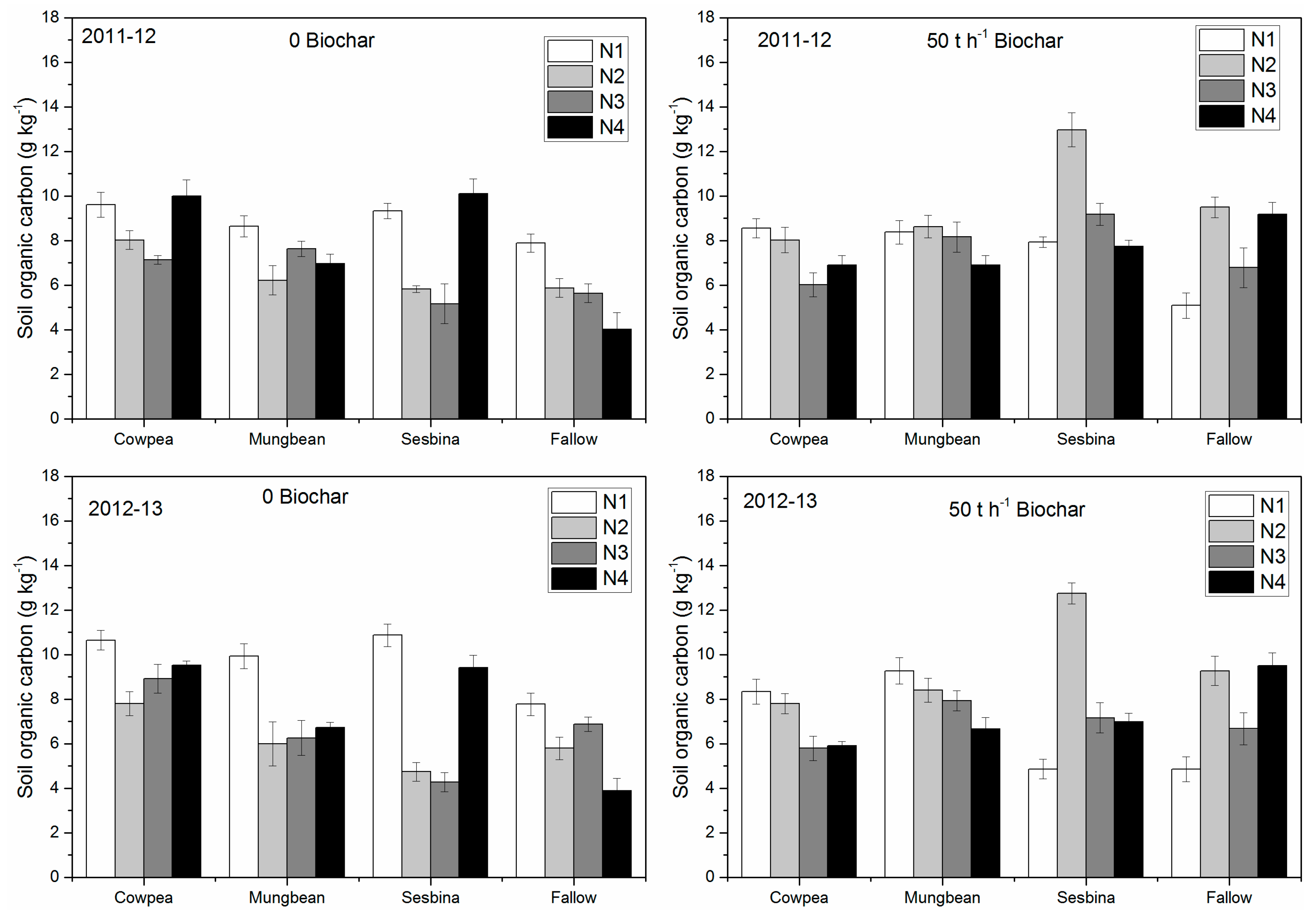
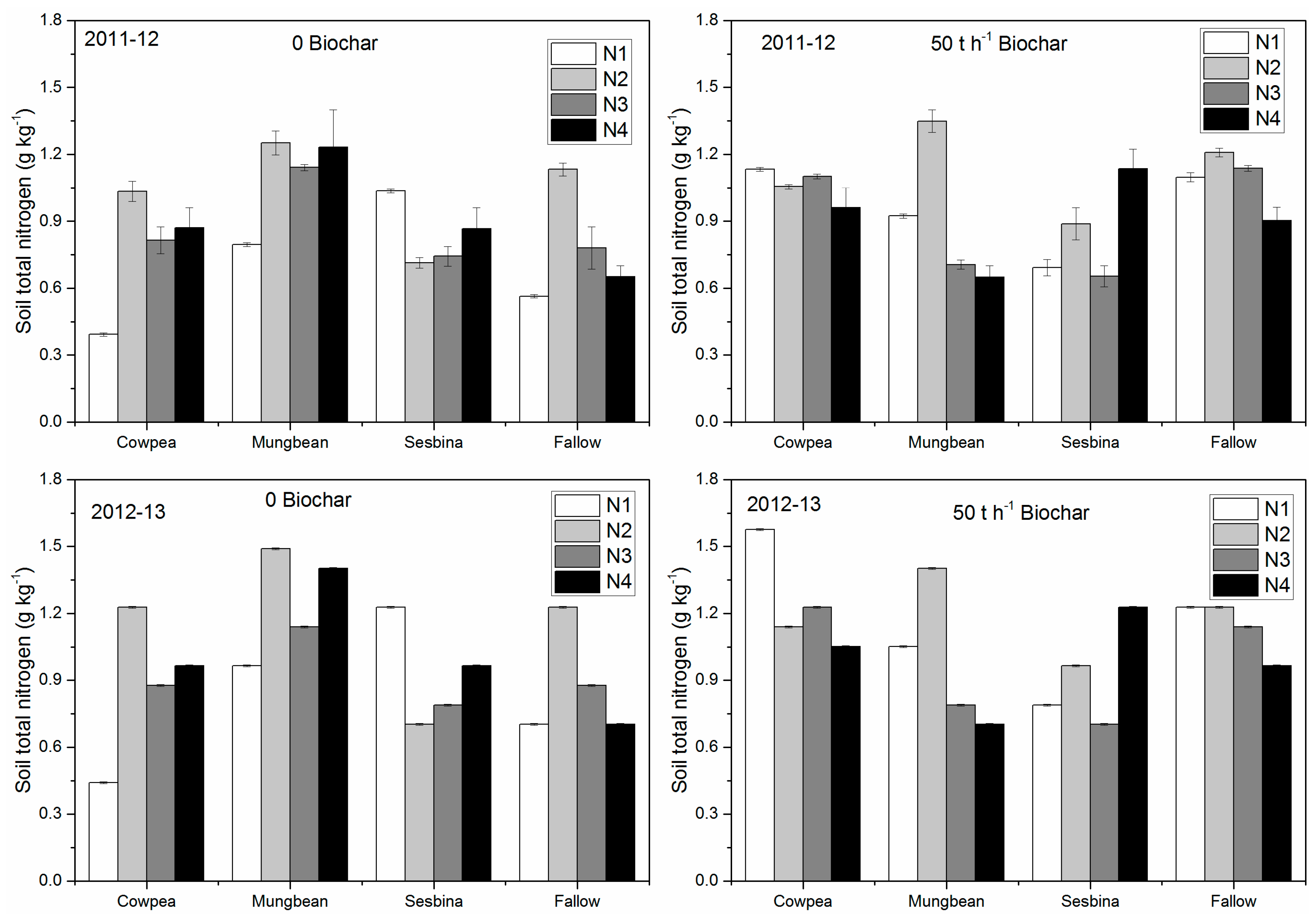
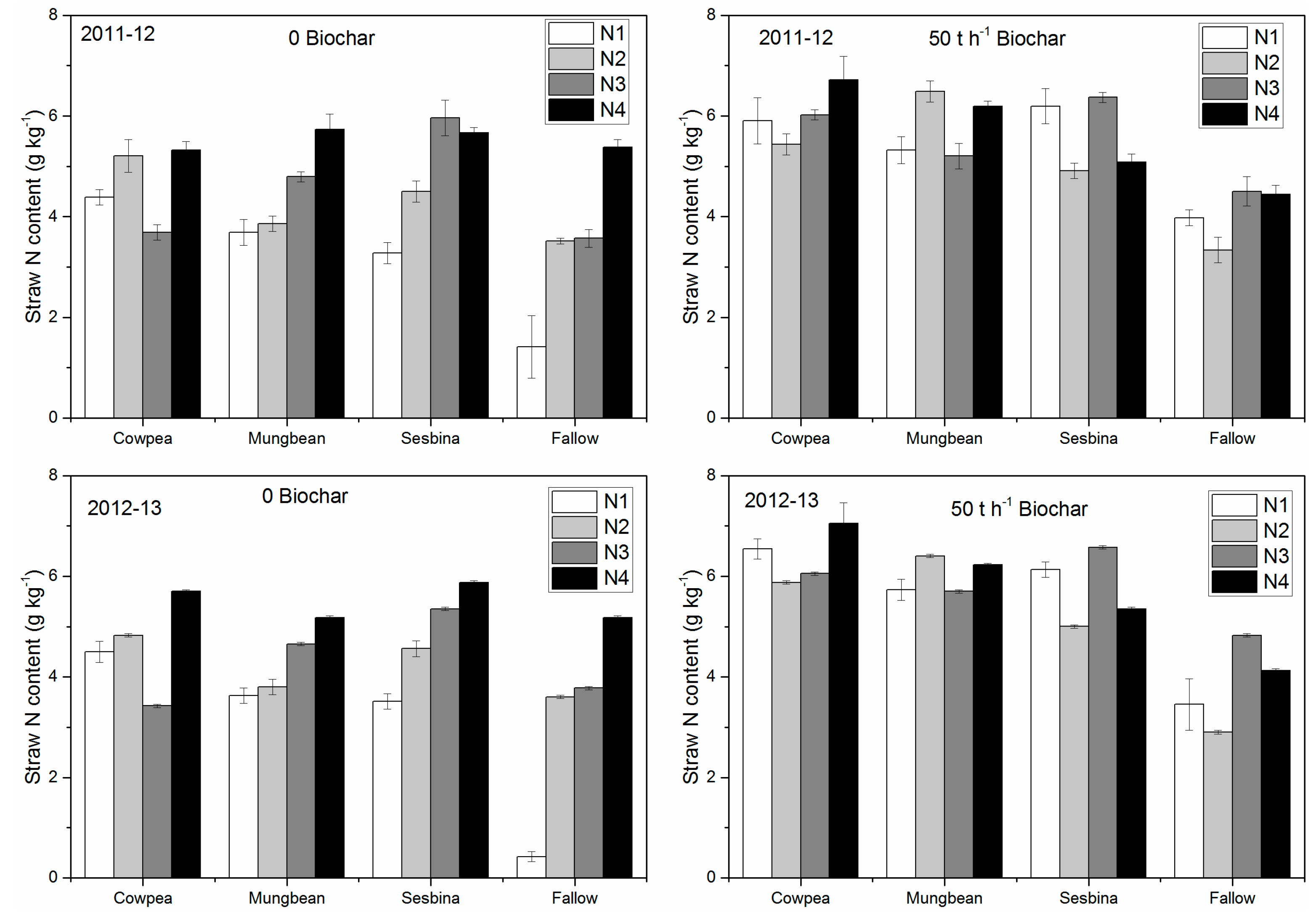
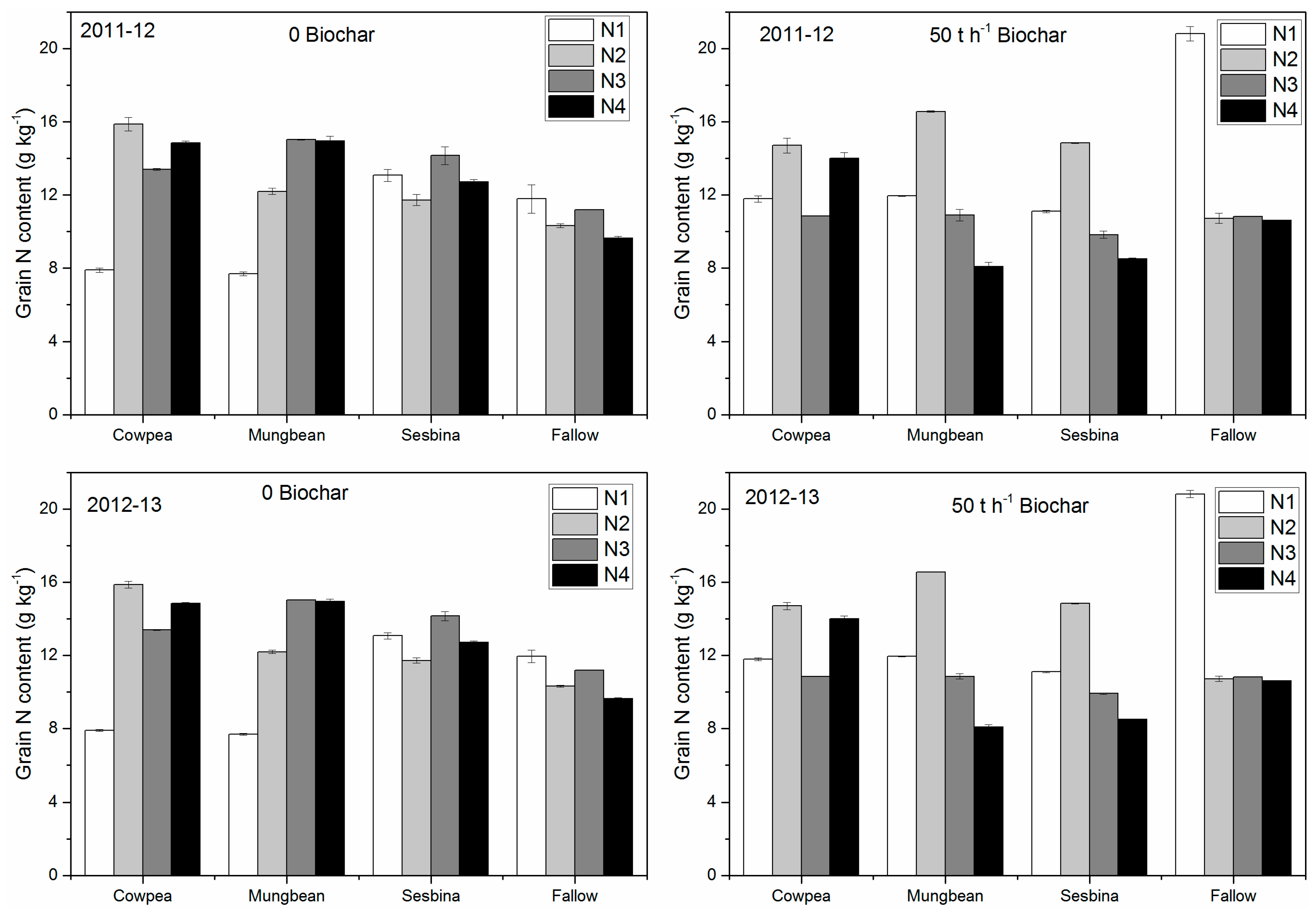
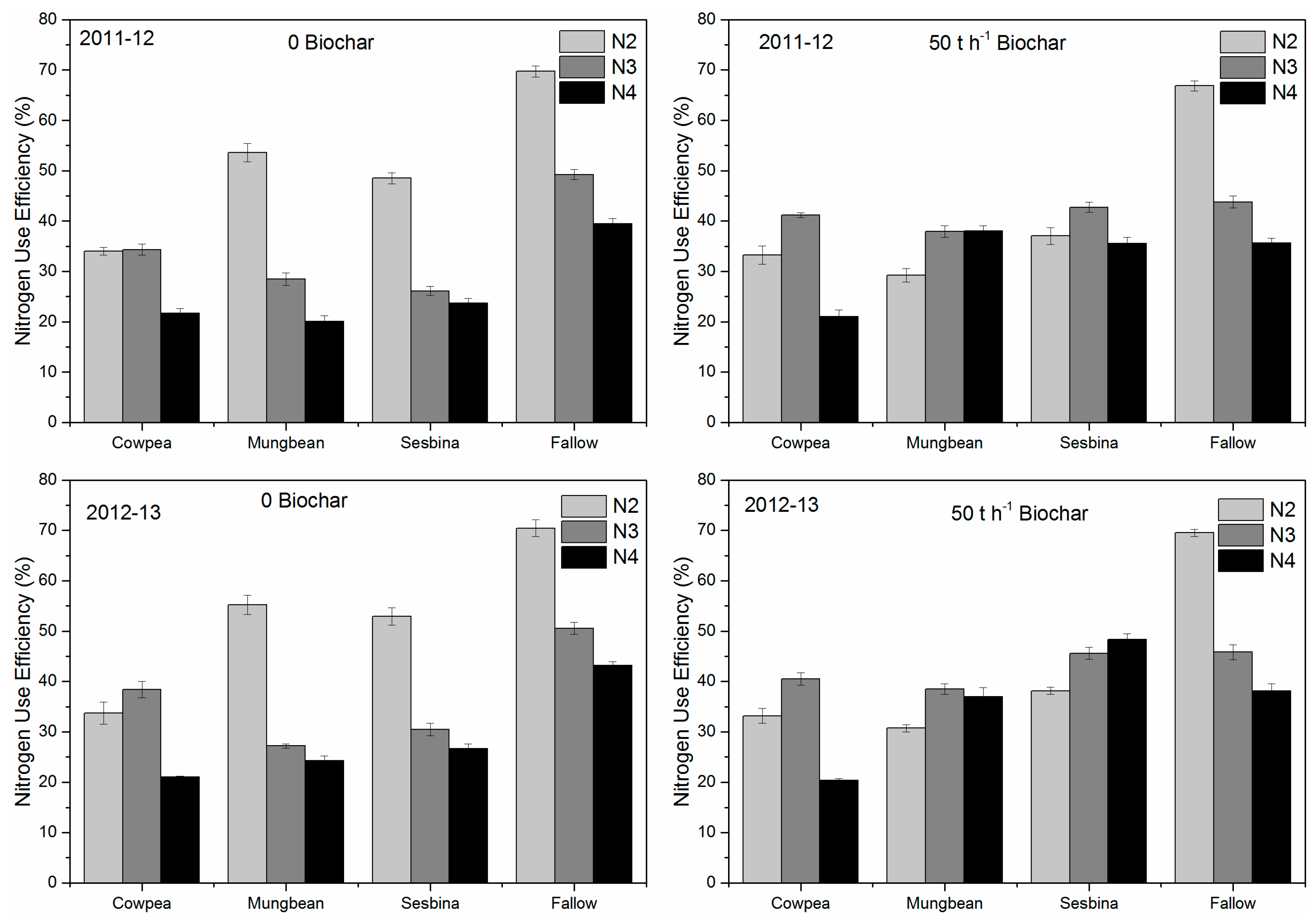
| Biochar (BC) (ton ha−1) | Legumes (L) | Nitrogen (N) (kg ha−1) | ||||
|---|---|---|---|---|---|---|
| 0 | 90 | 120 | 150 | Mean | ||
| 0 | Cowpea | 8.61 | 7.18 | 8.22 | 7.81 | 7.96 |
| 0 | Mungbean | 7.75 | 8.57 | 7.55 | 7.03 | 7.73 |
| 0 | Sesbania | 5.34 | 9.91 | 7.99 | 6.85 | 7.52 |
| 0 | Fallow | 7.13 | 9.56 | 7.68 | 7.15 | 7.38 |
| 50 | Cowpea | 9.24 | 6.44 | 7.99 | 7.73 | 7.85 |
| 50 | Mungbean | 8.52 | 8.98 | 8.72 | 8.05 | 8.59 |
| 50 | Sesbania | 10.04 | 9.81 | 11.63 | 10.68 | 10.54 |
| 50 | Fallow | 8.99 | 10.06 | 10.08 | 8.49 | 9.41 |
| BC × N | Mean | |||||
| 0 | 7.21 | 8.80 | 7.36 | 7.21 | 7.65 b | |
| 50 | 9.20 | 8.82 | 9.61 | 8.74 | 9.09 a | |
| L × N | Mean | |||||
| Cowpea | 8.93 | 7.81 | 8.11 | 7.77 | 7.90 | |
| Mungbean | 8.13 | 8.77 | 8.14 | 7.54 | 8.15 | |
| Sesbania | 7.69 | 9.86 | 9.81 | 8.77 | 9.03 | |
| Fallow | 8.06 | 8.81 | 7.88 | 7.82 | 8.39 | |
| 8.20 | 8.81 | 8.48 | 7.98 | |||
| Year | Year 1 | Year 2 | ||||
| 8.95 | 9.09 | |||||
| Main effects | LSD(0.05) | Interactions | Significance level | |||
| Year | ns | BC × L | * | |||
| Biochar (BC) | * | L × N | * | |||
| Legumes (L) | ns | BC × N | ns | |||
| Nitrogen (N) | ns | BC × L × N | * | |||
| Biochar (BC) (ton ha−1) | Legumes (L) | Nitrogen (N) (kg ha−1) | ||||
|---|---|---|---|---|---|---|
| 0 | 90 | 120 | 150 | Mean | ||
| 0 | Cowpea | 0.41 | 0.97 | 0.84 | 0.92 | 0.79 |
| 0 | Mungbean | 0.88 | 0.92 | 1.14 | 1.32 | 1.06 |
| 0 | Sesbania | 1.13 | 0.71 | 0.77 | 0.91 | 0.88 |
| 0 | Fallow | 0.63 | 0.98 | 0.84 | 0.68 | 0.78 |
| 50 | Cowpea | 1.35 | 0.79 | 1.16 | 1.01 | 1.08 |
| 50 | Mungbean | 0.95 | 1.14 | 0.80 | 0.67 | 0.89 |
| 50 | Sesbania | 0.77 | 0.97 | 1.00 | 1.18 | 0.98 |
| 50 | Fallow | 0.91 | 0.86 | 0.79 | 0.93 | 0.87 |
| BC × N | Mean | |||||
| 0 | 0.76 | 0.90 | 0.90 | 0.96 | 0.88 b | |
| 50 | 1.00 | 0.94 | 0.94 | 0.95 | 0.96 a | |
| L × N | Mean | |||||
| Cowpea | 0.88 | 0.88 | 1.00 | 0.96 | 0.93 a | |
| Mungbean | 0.91 | 1.03 | 0.97 | 1.00 | 0.98 a | |
| Sesbania | 0.95 | 0.84 | 0.88 | 1.05 | 0.93 ab | |
| Fallow | 0.77 | 0.92 | 0.82 | 0.80 | 0.83 b | |
| 0.88 b | 0.92 ab | 0.92 ab | 0.95 a | |||
| Year | Year 1 | Year 2 | ||||
| 0.86 b | 0.97 a | |||||
| Main effects | LSD(0.05) | Interactions | Significance level | |||
| Year | * | BC × L | * | |||
| Biochar (BC) | * | L × N | * | |||
| Legumes (L) | 0.074 | BC × N | * | |||
| Nitrogen (N) | 0.053 | BC × L × N | * | |||
| Biochar (BC) (ton ha−1) | Legumes (L) | Nitrogen (N) (kg ha−1) | ||||
|---|---|---|---|---|---|---|
| 0 | 90 | 120 | 150 | Mean | ||
| 0 | Cowpea | 4.45 | 5.02 | 3.56 | 5.51 | 4.63 |
| 0 | Mungbean | 3.66 | 3.83 | 4.72 | 5.45 | 4.42 |
| 0 | Sesbania | 3.40 | 4.53 | 5.66 | 5.77 | 4.84 |
| 0 | Fallow | 0.92 | 3.56 | 3.67 | 5.28 | 3.36 |
| 50 | Cowpea | 6.22 | 5.66 | 6.04 | 6.89 | 6.20 |
| 50 | Mungbean | 5.52 | 6.44 | 5.45 | 6.21 | 5.91 |
| 50 | Sesbania | 6.17 | 4.96 | 6.47 | 5.22 | 5.70 |
| 50 | Fallow | 3.72 | 3.12 | 4.67 | 4.29 | 3.95 |
| BC × N | Mean | |||||
| 0 | 3.10 | 4.23 | 4.40 | 5.50 | 4.31 b | |
| 50 | 5.41 | 5.04 | 5.66 | 5.65 | 5.44 a | |
| L × N | Mean | |||||
| Cowpea | 5.33 | 5.34 | 4.80 | 6.20 | 5.42 a | |
| Mungbean | 4.59 | 5.14 | 5.09 | 5.83 | 5.16 b | |
| Sesbania | 4.78 | 4.74 | 6.07 | 5.50 | 5.27 ab | |
| Fallow | 2.32 | 3.34 | 4.17 | 4.78 | 3.65 c | |
| 4.26 d | 4.64 c | 5.03 b | 5.58 a | |||
| Year | Year 1 | Year 2 | ||||
| 4.88 | 4.87 | |||||
| Main effects | LSD(0.05) | Interactions | Significance level | |||
| Year | Ns | BC × L | * | |||
| Biochar(BC) | * | L × N | ns | |||
| Legumes(L) | 0.18 | BC × N | ns | |||
| Nitrogen (N) | 0.14 | BC × L × N | ns | |||
| Biochar (BC) (ton ha−1) | Legumes (L) | Nitrogen (N) (kg ha−1) | ||||
|---|---|---|---|---|---|---|
| 0 | 90 | 120 | 150 | Mean | ||
| 0 | Cowpea | 7.90 | 15.86 | 13.40 | 14.85 | 13.00 |
| 0 | Mungbean | 7.69 | 12.20 | 15.03 | 14.95 | 12.47 |
| 0 | Sesbania | 13.08 | 11.73 | 14.15 | 12.73 | 12.92 |
| 0 | Fallow | 11.87 | 10.33 | 11.20 | 9.65 | 10.76 |
| 50 | Cowpea | 11.79 | 14.70 | 10.85 | 14.01 | 12.84 |
| 50 | Mungbean | 11.95 | 16.56 | 10.88 | 8.10 | 11.87 |
| 50 | Sesbania | 11.10 | 14.84 | 9.88 | 8.50 | 11.08 |
| 50 | Fallow | 20.81 | 10.73 | 10.83 | 10.62 | 13.25 |
| BC × N | Mean | |||||
| 0 | 10.13 | 12.53 | 13.44 | 13.04 | 12.29 | |
| 50 | 13.91 | 14.21 | 10.61 | 10.31 | 12.26 | |
| L × N | Mean | |||||
| Cowpea | 9.84 | 14.28 | 12.13 | 15.43 | 12.92 a | |
| Mungbean | 9.82 | 11.38 | 12.95 | 14.53 | 12.17 b | |
| Sesbania | 12.09 | 10.28 | 12.01 | 13.61 | 12.00 c | |
| Fallow | 11.34 | 10.53 | 11.01 | 10.13 | 10.75 d | |
| 10.77 d | 11.37 c | 12.03 b | 13.68 a | |||
| Year | Year 1 | Year 2 | ||||
| 12.27 | 12.28 | |||||
| Main effects | LSD(0.05) | Interactions | Significance level | |||
| Year | ns | BC × L | * | |||
| Biochar (BC) | ns | L × N | * | |||
| Legumes (L) | 0.13 | BC × N | ns | |||
| Nitrogen (N) | 0.15 | BC × L × N | * | |||
| Biochar (BC) (ton ha−1) | Legumes (L) | Nitrogen (N) (kg ha−1) | ||||
|---|---|---|---|---|---|---|
| 0 | 90 | 120 | 150 | Mean | ||
| 0 | Cowpea | - | 33.86 | 36.35 | 21.34 | 22.89 |
| 0 | Mungbean | - | 54.42 | 27.82 | 22.17 | 26.10 |
| 0 | Sesbania | - | 50.72 | 28.28 | 25.13 | 26.03 |
| 0 | Fallow | - | 70.09 | 49.90 | 41.33 | 40.33 |
| 50 | Cowpea | - | 33.21 | 40.84 | 20.68 | 23.68 |
| 50 | Mungbean | - | 29.97 | 38.22 | 37.48 | 26.41 |
| 50 | Sesbania | - | 37.60 | 44.16 | 41.96 | 30.93 |
| 50 | Fallow | - | 68.19 | 44.80 | 36.86 | 37.46 |
| BC × N | Mean | |||||
| 0 | - | 52.27 | 35.59 | 27.49 | 28.84 | |
| 50 | - | 42.24 | 42.00 | 34.24 | 29.62 | |
| L × N | Mean | |||||
| Cowpea | - | 33.53 | 38.59 | 21.01 | 23.28 d | |
| Mungbean | - | 42.20 | 33.02 | 29.82 | 26.26 c | |
| Sesbania | - | 44.16 | 36.22 | 33.54 | 28.48 b | |
| Fallow | - | 69.14 | 47.35 | 39.10 | 38.90 a | |
| - | 47.26 a | 38.80 b | 30.87 c | |||
| Year | Year 1 | Year 2 | ||||
| 28.47 | 29.99 | |||||
| Main effects | LSD(0.05) | Interactions | Significance level | |||
| Year | * | BC × L | * | |||
| Biochar (BC) | ns | BC × N | * | |||
| Legumes (L) | 2.29 | L × N | * | |||
| Nitrogen (N) | 1.49 | BC × L × N | * | |||
| Biochar (BC) (ton ha−1) | Legumes (L) | Nitrogen (N) (kg ha−1) | ||||
|---|---|---|---|---|---|---|
| 0 | 90 | 120 | 150 | Mean | ||
| 0 | Cowpea | 5193 | 6134 | 7378 | 8127 | 6708 |
| 0 | Mungbean | 5080 | 6153 | 7766 | 7295 | 6574 |
| 0 | Sesbania | 5512 | 6399 | 8060 | 7767 | 6935 |
| 0 | Fallow | 4742 | 5457 | 6642 | 7294 | 6034 |
| 50 | Cowpea | 6453 | 7305 | 9344 | 10480 | 8396 |
| 50 | Mungbean | 5953 | 6610 | 8878 | 8644 | 7521 |
| 50 | Sesbania | 6204 | 6828 | 8192 | 8206 | 7358 |
| 50 | Fallow | 5045 | 5994 | 6470 | 6814 | 6081 |
| BC × N | Mean | |||||
| 0 | 5193 | 6134 | 7378 | 8127 | 6708 a | |
| 50 | 5080 | 6153 | 7766 | 7295 | 6574 b | |
| L × N | Mean | |||||
| Cowpea | 5823 | 6720 | 8361 | 9303 | 7552 a | |
| Mungbean | 5516 | 6382 | 8322 | 7969 | 7047 a | |
| Sesbania | 5858 | 6614 | 8126 | 7987 | 7146 a | |
| Fallow | 4893 | 5725 | 6556 | 7054 | 6057 b | |
| 5523 c | 6360 b | 7841 a | 8078 a | |||
| Year | Year 1 | Year 2 | ||||
| 6278 b | 7623 a | |||||
| Main effects | LSD(0.05) | Interactions | Significance level | |||
| Year | * | BC × L | * | |||
| Biochar(BC) | * | L × N | * | |||
| Legumes(L) | 600.17 | BC × N | ns | |||
| Nitrogen (N) | 351.25 | BC × L × N | ns | |||
| Biochar (BC) (ton ha−1) | Legumes (L) | Nitrogen (N) kg ha−1 | ||||
|---|---|---|---|---|---|---|
| 0 | 90 | 120 | 150 | Mean | ||
| 0 | Cowpea | 1904 | 2439 | 3135 | 3032 | 2628 |
| 0 | Mungbean | 2123 | 2511 | 3038 | 3173 | 2711 |
| 0 | Sesbania | 2054 | 2258 | 3041 | 2839 | 2548 |
| 0 | Fallow | 2000 | 2249 | 3147 | 3194 | 2647 |
| 50 | Cowpea | 2658 | 2397 | 3833 | 3663 | 3138 |
| 50 | Mungbean | 2710 | 2669 | 3159 | 3065 | 2901 |
| 50 | Sesbania | 2495 | 2708 | 3397 | 3073 | 2918 |
| 50 | Fallow | 1977 | 2400 | 2639 | 2650 | 2416 |
| BC × N | Mean | |||||
| 0 | 2021 | 2364 | 3090 | 3060 | 2634 b | |
| 50 | 2460 | 2544 | 3257 | 3113 | 2843 a | |
| L × N | Mean | |||||
| Cowpea | 2281 | 2418 | 3484 | 3348 | 2883 a | |
| Mungbean | 2417 | 2590 | 3099 | 3119 | 2806 a | |
| Sesbania | 2275 | 2483 | 3219 | 2956 | 2733 a | |
| Fallow | 1988 | 2324 | 2893 | 2922 | 2532 b | |
| 2240 c | 2454 b | 3174 a | 3086 a | |||
| Year | Year 1 | Year 2 | ||||
| 2375 b | 3102 a | |||||
| Main effects | LSD(0.05) | Interactions | Significance level | |||
| Year | * | BC × L | * | |||
| Biochar (BC) | * | L × N | ns | |||
| Legumes (L) | 191.17 | BC × N | ns | |||
| Nitrogen (N) | 160.64 | BC × L × N | ns | |||
© 2020 by the authors. Licensee MDPI, Basel, Switzerland. This article is an open access article distributed under the terms and conditions of the Creative Commons Attribution (CC BY) license (http://creativecommons.org/licenses/by/4.0/).
Share and Cite
Jalal, F.; Arif, M.; Akhtar, K.; Khan, A.; Naz, M.; Said, F.; Zaheer, S.; Hussain, S.; Imtiaz, M.; Khan, M.A.; et al. Biochar Integration with Legume Crops in Summer Gape Synergizes Nitrogen Use Efficiency and Enhance Maize Yield. Agronomy 2020, 10, 58. https://doi.org/10.3390/agronomy10010058
Jalal F, Arif M, Akhtar K, Khan A, Naz M, Said F, Zaheer S, Hussain S, Imtiaz M, Khan MA, et al. Biochar Integration with Legume Crops in Summer Gape Synergizes Nitrogen Use Efficiency and Enhance Maize Yield. Agronomy. 2020; 10(1):58. https://doi.org/10.3390/agronomy10010058
Chicago/Turabian StyleJalal, Fazal, Muhammad Arif, Kashif Akhtar, Aziz Khan, Misbah Naz, Fazal Said, Sajjad Zaheer, Syed Hussain, Muhammad Imtiaz, Muhammad Ali Khan, and et al. 2020. "Biochar Integration with Legume Crops in Summer Gape Synergizes Nitrogen Use Efficiency and Enhance Maize Yield" Agronomy 10, no. 1: 58. https://doi.org/10.3390/agronomy10010058
APA StyleJalal, F., Arif, M., Akhtar, K., Khan, A., Naz, M., Said, F., Zaheer, S., Hussain, S., Imtiaz, M., Khan, M. A., Ali, M., & Wei, F. (2020). Biochar Integration with Legume Crops in Summer Gape Synergizes Nitrogen Use Efficiency and Enhance Maize Yield. Agronomy, 10(1), 58. https://doi.org/10.3390/agronomy10010058








